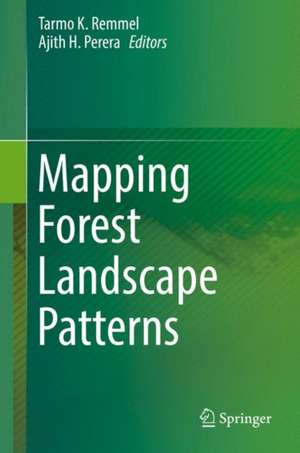Mapping Forest Landscape Patterns
Editat de Tarmo K. Remmel, Ajith H. Pereraen Limba Engleză Hardback – 9 sep 2017
| Toate formatele și edițiile | Preț | Express |
|---|---|---|
| Paperback (1) | 628.57 lei 38-44 zile | |
| Springer – 18 aug 2018 | 628.57 lei 38-44 zile | |
| Hardback (1) | 1116.09 lei 6-8 săpt. | |
| Springer – 9 sep 2017 | 1116.09 lei 6-8 săpt. |
Preț: 1116.09 lei
Preț vechi: 1361.08 lei
-18% Nou
Puncte Express: 1674
Preț estimativ în valută:
213.63€ • 232.13$ • 179.57£
213.63€ • 232.13$ • 179.57£
Carte tipărită la comandă
Livrare economică 21 aprilie-05 mai
Preluare comenzi: 021 569.72.76
Specificații
ISBN-13: 9781493973293
ISBN-10: 1493973290
Pagini: 426
Ilustrații: XIV, 326 p. 125 illus., 94 illus. in color.
Dimensiuni: 155 x 235 mm
Greutate: 0.65 kg
Ediția:1st ed. 2017
Editura: Springer
Colecția Springer
Locul publicării:New York, NY, United States
ISBN-10: 1493973290
Pagini: 426
Ilustrații: XIV, 326 p. 125 illus., 94 illus. in color.
Dimensiuni: 155 x 235 mm
Greutate: 0.65 kg
Ediția:1st ed. 2017
Editura: Springer
Colecția Springer
Locul publicării:New York, NY, United States
Cuprins
Preface.- Chapter 1: Mapping forest landscapes: overview and a primer.- Chapter 2: Fuzzy classification of vegetation for ecosystem mapping.- Chapter 3: Portraying wildfires in forest landscapes as discrete complex objects.- Chapter 4: Airborne LiDAR applications in forest landscapes.- Chapter 5: Regression Tree modeling of spatial pattern and process interactions.- Chapter 6: Mapping the abstractions of forest landscape patterns.- Chapter 7: Towards automated forest mapping.- Epilogue: Toward more efficient and effective applications of forest landscape maps.
Notă biografică
Tarmo K. Remmel, Ph.D. (University of Toronto), Associate Professor of Geography at York University: A GIScientist with over 10 years of experience teaching and conducting research involving remote sensing, GIS, and spatial statistics, Dr. Remmel focuses primarily on boreal forests, with a particular emphasis on wildfire disturbances and on the development of algorithms for measuring and assessing spatial patterns, planar shapes, and the quantification of spatial change and accuracy. A strong proponent of free and open source software tools, particularly within the R-project to facilitate implementation, his work integrates field-level data collection with remotely sensed imagery obtained from satellite, aircraft, and UAV platforms to characterize the effects of scale.
Ajith H. Perera, Ph.D. (Penn State University), Senior Research Scientist and leader of the forest landscape ecology program at Ontario Forest Research Institute, Ontario Ministry of Natural Resources, adjunct professor at University of Waterloo, York University and University of Guelph: With over 25 years research experience in landscape ecology, Dr. Perera’s major focus is on quantifying and modeling spatio-temporal patterns in boreal forest disturbances. He has authored over 150 science publications, and been senior editor, co-editor and author of eight books on Forest Landscape Ecology.
Ajith H. Perera, Ph.D. (Penn State University), Senior Research Scientist and leader of the forest landscape ecology program at Ontario Forest Research Institute, Ontario Ministry of Natural Resources, adjunct professor at University of Waterloo, York University and University of Guelph: With over 25 years research experience in landscape ecology, Dr. Perera’s major focus is on quantifying and modeling spatio-temporal patterns in boreal forest disturbances. He has authored over 150 science publications, and been senior editor, co-editor and author of eight books on Forest Landscape Ecology.
Textul de pe ultima copertă
This book explores the concepts, premises, advancements, and challenges in quantifying natural forest landscape patterns through mapping techniques. After several decades of development and use, these tools can now be examined for their foundations, intentions, scope, advancements, and limitations. When applied to natural forest landscapes, mapping techniques must address concepts such as stochasticity, heterogeneity, scale dependence, non-Euclidean geometry, continuity, non-linearity, and parsimony, as well as be explicit about the intended degree of abstraction and assumptions. These studies focus on quantifying natural (i.e., non-human engineered) forest landscape patterns, because those patterns are not planned, are relatively complex, and pose the greatest challenges in cartography, and landscape representation for further interpretation and analysis.
Caracteristici
Explores the concepts, premises, advancements and challenges in quantifying natural forest landscape patterns through mapping and modeling techniques Presents a series of case study examples of the latest technological advancements in mapping Offers a collection of topical syntheses that cover the state of knowledge on characterizing, representing, and mapping of natural forest landscapes, and suggests opportunities and needs for future research Includes supplementary material: sn.pub/extras
